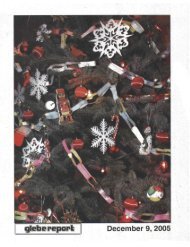Glebe Report - Volume 32 Number 6- June 14 2002
Glebe Report - Volume 32 Number 6- June 14 2002
Glebe Report - Volume 32 Number 6- June 14 2002
You also want an ePaper? Increase the reach of your titles
YUMPU automatically turns print PDFs into web optimized ePapers that Google loves.
31 <strong>Glebe</strong> <strong>Report</strong> <strong>June</strong> <strong>14</strong>, <strong>2002</strong> BOOKS<br />
Wondrous photos of world's most planted flower<br />
TULIPS: FACTS AND FOLKLORE<br />
ABOUT THE WORLD'S MOST<br />
PLANTED FLOWER<br />
Photographs by Malak,<br />
Text by Sonia Day<br />
Key Porter Books,<br />
128 pages, $24.95 (cloth)<br />
Tulips, illustrated with photographs<br />
by Malak, was published<br />
on the occasion of the 50th anniversary<br />
of the Canadian Tulip<br />
Festival. Coinciding with the festival<br />
is a retrospective exhibition<br />
of photography, April 13 to <strong>June</strong><br />
13, at the Canadian Museum of<br />
Photography, by Malak Karsh<br />
(1915-2001), founder of the festival.<br />
Sadly, Malak is no longer<br />
among us to enjoy this triple<br />
celebration, the book, the showcasing<br />
of his lifetime of work at a<br />
national museum, and spring in<br />
his beloved Ottawa.<br />
Still, record-cool temperatures<br />
enabled the tulips, one of Malak's<br />
favourite subjects to last much<br />
longer than usual. April and May,<br />
with the exception of a few warm<br />
sunny days, resembled the dull<br />
grey days of November, the backdrop<br />
providing a striking contrast<br />
to the wondrous splendour<br />
of the parade of colour, the capital's<br />
most natural gift-100,000<br />
tulip bulbs bequeathed to Canada<br />
by Queen Juliana of the Netherlands<br />
to thank our country for its<br />
role in liberating the Netherlands<br />
in the Second World War, and for<br />
providing a safe haven for the<br />
Dutch royal family during Holland's<br />
occupation by the Germans.<br />
Tulips like cold weatherit<br />
nourishes their bulbs' tunics,<br />
several layers or skins similar to<br />
those found on onions and for<br />
which tulip bulbs can be substituted<br />
for a rare gastronomic delight.<br />
Facts and folklore about the<br />
world's most planted flower include<br />
a surprising section called<br />
Tulips à la carte. You can substitute<br />
tulip bulbs for onions in<br />
any recipe. How about this one for<br />
tomato sauce with a difference?<br />
"Slice two tulip bulbs and sauté<br />
them in olive oil and a little garlic.<br />
Add four cups of peeled<br />
chopped tomatoes and simmer for<br />
about half an hour. Serve over<br />
pasta with parmesan cheese."<br />
What's inside the tulip can be<br />
eaten toostamens and ovaries<br />
taste like asparagus. You can eat<br />
them steamed or sauté them in<br />
butter. For that special dessert,<br />
try candied tulip petals picked<br />
the same day, dipped in beaten<br />
egg batter (shake off excess egg).<br />
Then petals coated with fine<br />
By<br />
Sharon<br />
Abron<br />
Drache<br />
sugar on both sides are spread on<br />
a baking sheet and baked until<br />
dry and slightly crisp. One<br />
warning about bulbs and flowersmake<br />
sure they have not been<br />
treated with pesticides!<br />
This compendium guide includes<br />
the history of the tulip's<br />
romantic and economic past Passages<br />
about the flower occur in<br />
early Persian legends of love. The<br />
brilliant colours of tulips inspired<br />
French impressionist<br />
painter Claude Monet's famous<br />
paintings of water lilies. Victorian<br />
poet Robert Browning<br />
praised the tulip in his poem, Up<br />
at a VillaDown in the City: "Mid<br />
the sharp short emerald wheat,<br />
scarce risen three fingers well,/<br />
The wild tulip, at the end of its<br />
tube, blows out its great red bell/<br />
Like a thin clear bubble of blood<br />
for the children to pick and sell."<br />
The first central European to<br />
discover the new flower in Turkey,<br />
Ogier Ghiselin de Busbecq (a<br />
Flemish diplomat), was actually<br />
responsible for renaming the luscious<br />
bloom, which the Turks<br />
called lale (pronounced lah-lay),<br />
and wanted to share the knowledge<br />
of his wondrous discovery.<br />
However, in 1573, Dutch horticulturalist<br />
Carolus Clusius<br />
brought tulip seeds back from<br />
Constantinople and began cultivating<br />
and hoarding tulips in his<br />
6otanical garden at Leiden. Clusius<br />
planted his precious tulips<br />
in a walled garden. This encouraged<br />
his neighbours to scale the<br />
wall and steal the bulbs for their<br />
own gardens, and thus began the<br />
love affair with this new flower<br />
that has lasted for more than 400<br />
years.<br />
The tulip, which was a strikingly<br />
different flower, became a<br />
status symbol, flaunted by the<br />
elite. From 1625 to 1637, "tulipomania"<br />
gripped Holland. Someone<br />
who acquired a tulip wouldn't<br />
necessarily choose to take it home<br />
and plant it in his garden. Instead,<br />
he would trade it to someone<br />
else at a higher price, like a<br />
short-term trader in the stock<br />
market. The men who handled<br />
such transactions could pull in as<br />
much as 60,000 florins a month-<br />
that is $44,000 in today's money.<br />
Go back to the 17th centuty before<br />
inflation and you arrive at an<br />
even more staggering sum. As one<br />
might expect, those persons who<br />
could least afford the risk jumped<br />
on the bandwagon, offering their<br />
homes as collateral if they<br />
couldn't scrape together enough<br />
cashfor example, an entire house<br />
for one tulip bulb! So powerful<br />
was the tulip market that if people<br />
couldn't afford to plant them<br />
in their gardens, they wanted to<br />
buy paintings of them to decorate<br />
the walls of their homes. Artists<br />
who used tulips for their subjects<br />
became very popular and were<br />
justly compensated.<br />
Forward to <strong>2002</strong>, and Ottawa's<br />
. FACT S AND FOLK 0 R<br />
ABOUT T H MCA:<br />
moST. P.LA T L 0 R<br />
annual tulip festival. The tulip<br />
season is over, but Malak, who<br />
died in November 2001, is very<br />
much with us. His wondrous photographs,<br />
synonymous with the<br />
annual festival he founded back<br />
in 1951, are part of the permanent<br />
collection of the Canadian<br />
Museum of Contemporary Photography,<br />
and these splendid photos<br />
also grace the pages of many<br />
photography books and are owned<br />
by individual collectors throughout<br />
Canada and the world.<br />
This book is one more tribute<br />
to Malak and his work, and also<br />
an entertaining and all-inclusive<br />
compendium about the world's<br />
most planted flower.<br />
RICHARD PATTEN, MPP<br />
OTTAWA CENTRE<br />
1292 Wellington Street<br />
K1Y 3A9<br />
Tel: 722-64<strong>14</strong> Fax: 722-6703<br />
Richard Patten-MPP-00@ontla.ola.org<br />
For Six to Eight year-olds<br />
Annabella and the<br />
WereWolves of Whale Cove<br />
By <strong>Glebe</strong> author JC Sulzenko<br />
$ 7.95<br />
Available at Mother Tongue Books, Leishman Books and from bluepoodlebooks@hotmail.com<br />
Great for the holidays and kids who love the sea<br />
Lansdowne<br />
Animal<br />
Hospital<br />
T Zarkeciwari D.V.M., M.S.<br />
281 Sunnyside Ave.<br />
(corner of Bank & Sunnyside)<br />
730-2460<br />
Monday to Friday 8 - 7 Saturday 9 - 4

















